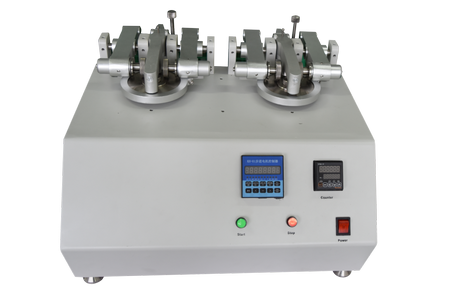
NewsInformation Center
Analysis of the evaluation of textile wear performance by Taber abrasion tester
2023/02/09
Taber Abrasion Tester is used for abrasion tests of various textiles, cloth, paper, paint, plywood, leather, floor tiles, glass, natural rubber, plastic sheets and other materials to evaluate the wear performance of materials.
Applicable standard:
ISO 5470-1, ASTM D4060, ASTM D3884, DIN53863.2, GB 4085
Test principle:
Apply a specified load and speed to the test sample placed on the test bench. When the test bench rotates, it drives the abrasive wheel to wear the sample. The weight lost by abrasion is the difference in weight between the samples before and after the test. The wear resistance is estimated according to the standard method.

Result rating:
The evaluation of wear resistance can be compared with the standard sample of the same nature under the same test conditions. It is suggested to observe from the following aspects.
1. Appearance and performance:
Changes in gloss: changes in surface properties (pilling, fuzzing);
Color change: first time fiber breakage seen, first hole found.
2. Physical properties:
changes in thickness;
Changes in breathability;
changes in weight;
Changes in force (stretching or crushing).
3. Weightlessness method:
The weight loss per unit area is the difference between the original weight of the sample and the weight after wear, and the percentage of the worn area of the sample, that is:
Weight loss per unit area = W0-W1/S
In the formula:
W0---the original weight of the sample (g);
W1---the weight of the sample after wear (g);
S---sample wear area (cm2)--this instrument is 20cm2;
If the calculated data is too small, it can be converted into g/m2.
4. Loss of strength method:
The strength difference (%) is the difference between the original strength of the sample and the strength after wear, and the percentage of the original strength, that is:
Intensity difference (%)=A0-A/A0;
In the formula: A0---the original strength of the sample (N);
A---The strength of the sample after abrasion (N).
Previous: What is the filtration principle of a medical mask?
N e x t : What is the principle of the mask vision tester test?



